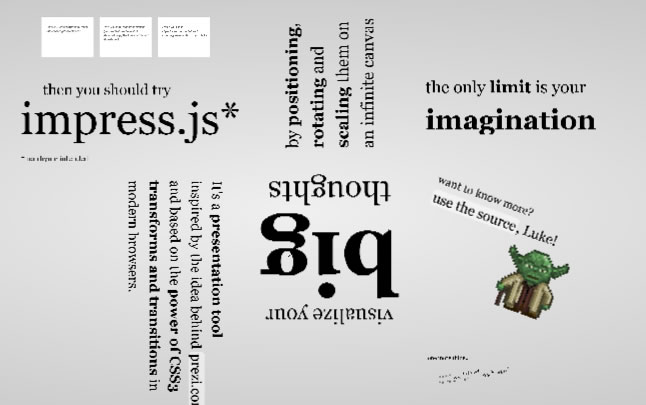impress lightbox effect

It's a presentation framework based on the power of CSS3 transforms and transitions in modern browsers and inspired by the idea behind prezi.com.
Currently impress.js works fine in latest Chrome/Chromium browser, Safari 5.1 and Firefox 10. With addition of some HTML5 polyfills (see below for details) it should work in Internet Explorer 10 (currently available as Developers Preview). It doesn't work in Opera, as it doesn't support CSS 3D transforms.
TL;DR;
Currently impress.js works fine in latest Chrome/Chromium browser, Safari 5.1 and Firefox 10. With addition of some HTML5 polyfills (see below for details) it should work in Internet Explorer 10 (currently available as Developers Preview). It doesn't work in Opera, as it doesn't support CSS 3D transforms.
As a presentation tool it was not developed with mobile browsers in mind, but some tablets are good enough to run it, so it should work quite well on iPad (iOS 5, or iOS 4 with HTML5 polyfills) and Blackberry Playbook.
Still interested? Read more...
Additionally for the animations to run smoothly it's required to have hardware acceleration support in your browser. This depends on the browser, your operating system and even kind of graphic hardware you have in your machine.
For browsers not supporting CSS3 3D transforms impress.js adds impress-not-supported class on #impress element, so fallback styles can be applied to make all the content accessible.
Even more explanation and technical stuff
Let's put this straight -- wide browser support was (and is) not on top of my priority list for impress.js. It's built on top of fresh technologies that just start to appear in the browsers and I'd like to rather look forward and develop for the future than being slowed down by the past.
But it's not "hard-coded" for any particular browser or engine. If any browser in future will support features required to run impress.js, it will just begin to work there without changes in the code.
From technical point of view all the positioning of presentation elements in 3D requires CSS 3D transforms support. Transitions between presentation steps are based on CSS transitions. So these two features are required by impress.js to display presentation correctly.
Unfortunately the support for CSS 3D transforms and transitions is not enough for animations to run smoothly. If the browser doesn't support hardware acceleration or the graphic card is not good enough the transitions will be laggy.
Additionally the code of impress.js relies on APIs proposed in HTML5 specification, including classList and dataset APIs. If they are not available in the browser, impress.js will not work.
Fortunately, as these are JavaScript APIs there are polyfill libraries that patch older browsers with these APIs.
For example IE10 is said to support CSS 3D transforms and transitions, but it doesn't have classList not dataset APIs implemented at the moment. So including polyfill libraries should help IE10 with running impress.js.
And few more details about mobile support
Mobile browsers are currently not supported. Even Android browsers that support CSS 3D transforms are forced into fallback view at this point.
Fortunately some tablets seem to have good enough hardware support and browsers to handle it. Currently impress.js presentations should work on iPad and Blackberry Playbook.
In theory iPhone should also be able to run it (as it runs the same software as iPad), but I haven't found a good way to handle it's small screen.
Also note that iOS supports classList and dataset APIs starting with version 5, so iOS 4.X and older requires polyfills to work.
Read more:https://github.com/bartaz/impress.js
You might also like
Tags
accordion accordion menu animation navigation animation navigation menu carousel checkbox inputs css3 css3 menu css3 navigation date picker dialog drag drop drop down menu drop down navigation menu elastic navigation form form validation gallery glide navigation horizontal navigation menu hover effect image gallery image hover image lightbox image scroller image slideshow multi-level navigation menus rating select dependent select list slide image slider menu stylish form table tabs text effect text scroller tooltips tree menu vertical navigation menu

 Subscribe
Subscribe Follow Us
Follow Us 11 years ago
11 years ago 25511
25511 3812
3812



